Geomorphological Changes of a Migrating Sandbank: Multidecadal Analysis as a Tool for Managing Conflicts in Coastal Use
Abstract
:1. Introduction
2. Study Area
2.1. Geographic Setting
2.2. Oceanographic and Meteoclimatic Forcing
3. Materials and Methods
4. Results
4.1. Morpho-Sedimentary Configuration
- Fine sand (2 < Mz < 3 phi) is the most common sediment type of the beaches as a result of natural wave dynamics along this fetch-limited and protected shoreline.
- Very fine sand (3 < Mz < 4 phi) occurs on the artificial beach between Grado and Grado Pineta, as well as on the barred shoreface in front of it, replaced by coarse silt from −3 m seawards.
- An inversion of the normal coast-to-sea transition (seaward fining) occurs in the coastal tract, which is seaward limited by the sandbanks (MMB and ID). Here, the finest sediments (>3.5 phi, but mostly medium and fine silt) dominate the intertidal flat facing the shoreline, confirming the backbarrier characteristics of the area. Seaward, the sediments with the coarsest Mz (<2.5 phi) follow the bar and trough zone close to the outer limit of the bank and upper shoreface, identifying this zone as the most dynamic and exposed to wave action. Here the western longshore is active, and longshore elongated bars are the dominant landforms.
- The seaward limit of the littoral sand prism can be identified between −5 and −6 m in the ID zone, while on the seabed of the MMB a vast zone of pure, fine sand extends up to −7/−8 m, corresponding to east-oriented sand bars, the origin of which is still unknown.
4.2. Multi-Decadal Evolution
4.2.1. First Period (1822–1830)
4.2.2. Second Period (1830–1894)
4.2.3. Third Period (1894–1938)
4.2.4. Fourth Period (1938–1954)
4.2.5. Fifth Period (1954–1978)
4.2.6. Sixth Period (1978–2007)
4.2.7. Seventh Period (2007–2019)
4.3. The Bank Migration
5. Discussion and Conclusions
5.1. The Sedimentary Surplus Anomaly and the Role of the Isonzo River
- the current presence of vast sandy shoals at the mouth of the Isonzo;
- the wide area of sandy accumulation with emerging banks in front of the Grado beach.
- the ebb-tidal delta with a volume between 600,000 and 850,000 m3 at the Primero inlet which can be considered in equilibrium with its hydraulic cross-section and tidal prism [59]. The full development of the ebb-tidal delta, which can be temporally placed between 1949 [58] and 1995 [59], indicates a very rapid growth which can be attributed to a sediment flux from east to west greater than 60,000 m3 y−1, calculated according to the Tidal Inlet Reservoir Model [76].
5.2. The Conflict between Natural Dynamics and Poor Urban Planning
5.3. Perspectives of Proper Coastal Management
Author Contributions
Funding
Institutional Review Board Statement
Informed Consent Statement
Data Availability Statement
Acknowledgments
Conflicts of Interest
References
- Church, J.A.; Clark, P.U.; Cazenave, A.; Gregory, J.M.; Jevrejeva, S.; Levermann, A.; Merrifield, M.A.; Milne, G.A.; Nerem, R.S.; Nunn, P.D.; et al. Sea level change. In Climate Change 2013: The Physical Science Basis. Contribution of Working Group I to the Fifth Assessment Report of the Intergovernmental Panel on Climate Change; Stocker, T.F., Qin, D., Plattner, G.-K., Tignor, M., Allen, S.K., Boschung, J., Nauels, A., Xia, Y., Bex, V., Midgley, P.M., Eds.; Cambridge University Press: Cambridge, UK; New York, NY, USA, 2013; Available online: https://www.ipcc.ch/site/assets/uploads/2018/02/WG1AR5_Chapter13_FINAL.pdf (accessed on 26 October 2021).
- Oppenheimer, M.; Glavovic, B.C.; Hinkel, J.; van de Wal, R.; Magnan, A.K.; Abd-Elgawad, A.; Cai, R.; Cifuentes-Jara, M.; DeConto, R.M.; Ghosh, T.; et al. Sea level rise and implications for low-lying islands, coasts and communities. IPCC Special Report on the Ocean and Cryosphere in a Changing Climate. Pörtner, H.-O., Roberts, D.C., Masson-Delmotte, V., Zhai, P., Tignor, M., Poloczanska, E., Mintenbeck, K., Alegría, A., Nicolai, M., Okem, A., et al., Eds.; 2019. Available online: https://www.ipcc.ch/srocc/chapter/chapter-4-sea-level-rise-and-implications-for-low-lying-islands-coasts-and-communities/ (accessed on 26 October 2021).
- Anthony, E.J.; Marriner, N.; Morhange, C. Human influence and the changing geomorphology of Mediterranean deltas and coasts over the last 6000 years: From progradation to destruction phase? Earth-Sci. Rev. 2014, 139, 336–361. [Google Scholar] [CrossRef]
- Besset, M.; Anthony, E.J.; Bouchette, F. Multi-decadal variations in delta shorelines and their relationship to river sediment supply: An assessment and review. Earth-Sci. Rev. 2019, 193, 199–219. [Google Scholar] [CrossRef] [Green Version]
- McManus, J. Deltaic responses to changes in river regimes. Mar. Chem. 2002, 79, 155–170. [Google Scholar] [CrossRef]
- Maselli, V.; Trincardi, F. Man made deltas. Sci. Rep. 2013, 3, 1926. [Google Scholar] [CrossRef] [Green Version]
- Stutz, M.L.; Pilkey, O.H. The relative influence of humans on barrier islands: Humans versus geomorphology. In Humans as Geologic Agents; Ehlen, J., Haneberg, W.C., Larson, R.A., Eds.; Geological Society of America: Boulder, CO, USA, 2005; Volume 16. [Google Scholar] [CrossRef]
- FitzGerald, D.M.; Fenster, M.S.; Argow, B.A.; Buynevich, I.V. Coastal impacts due to sea-level rise. Ann. Rev. Earth Plan. Sci. 2008, 36, 601–647. [Google Scholar] [CrossRef] [Green Version]
- McBride, R.A.; Anderson, J.B.; Buynevich, I.V.; Cleary, W.; Fenster, M.S.; FitzGerald, D.M.; Harris, M.S.; Hein, C.J.; Klein, A.H.F.; Liu, B.; et al. 10.8 Morphodynamics of barrier systems: A synthesis. In Treatise on Geomorphology; Shroder, J.F., Ed.; Academic Press: New York, NY, USA, 2013; Volume 10, pp. 166–244. [Google Scholar] [CrossRef]
- FitzGerald, D.M.; Hein, C.J.; Hughes, Z.; Kulp, M.; Georgiou, I.; Miner, M. Runaway barrier island transgression concept: Global case studies. In Barrier Dynamics and Response to Changing Climate; Moore, L.J., Murray, A.B., Eds.; Springer: Cham, Switzerland, 2018; pp. 3–56. [Google Scholar] [CrossRef]
- De la Vega-Leinert, A.C.; Nichols, R.J. Potential implications of sea-level rise for Great Britain. J. Coast. Res. 2008, 24, 342–357. [Google Scholar] [CrossRef]
- Martínez, M.L.; Hesp, P.A.; Gallego-Fernández, J.B. Coastal dunes: Human impact and need for restoration. In Restoration of Coastal Dunes; Martínez, M.L., Gallego-Fernández, J.B., Hesp, P.A., Eds.; Springer: Berlin/Heidelberg, Germany, 2013; pp. 1–14. [Google Scholar] [CrossRef]
- Psuty, N.P.; Silveira, T.M. Global climate change: An opportunity for coastal dunes?? J. Coast. Conserv. 2010, 14, 153–160. [Google Scholar] [CrossRef]
- Leatherman, S. Barrier dynamics and landward migration with Holocene sea-level rise. Nature 1983, 301, 415–417. [Google Scholar] [CrossRef]
- Cooper, J.A.G.; Masselink, G.; Coco, G.; Short, A.D.; Castelle, B.; Rogers, K.; Anthony, E.; Green, A.N.; Kelley, J.T.; Pilkey, O.H.; et al. Sandy beaches can survive sea-level rise. Nat. Clim. Chang. 2020, 10, 993–995. [Google Scholar] [CrossRef]
- Cooper, J.A.G.; Green, A.N.; Loureiro, C. Geological constraints on mesoscale coastal barrier behavior. Glob. Planet. Chang. 2018, 168, 15–34. [Google Scholar] [CrossRef] [Green Version]
- Zhang, K.; Douglas, B.; Leatherman, S. Do storms cause long-term beach erosion along the U.S. East Barrier Coast? J. Geol. 2002, 110, 493–502. [Google Scholar] [CrossRef]
- McBride, R.A.; Byrnes, M.R.; Hiland, M.W. Geomorphic response-type model for barrier coastlines: A regional perspective. Mar. Geol. 1995, 126, 143–159. [Google Scholar] [CrossRef]
- Hapke, C.J.; Himmelstoss, E.A.; Kratzmann, M.G.; List, J.H.; Thieler, E.R. National Assessment of Shoreline Change: Historical Shoreline Change along the New England and Mid-Atlantic Coasts; Open-File Report 2010-1118; U.S. Geological Survey: Reston, VA, USA, 2011; 57p. Available online: https://pubs.usgs.gov/of/2010/1118/ (accessed on 26 October 2021).
- Morton, R.A. Historical changes in the Mississippi-Alabama barrier-island chain and the roles of extreme storms, sea level, and human activities. J. Coast. Res. 2008, 24, 1587–1600. [Google Scholar] [CrossRef]
- Simeoni, U.; Fontolan, G.; Tessari, U.; Corbau, C. Domains of spit evolution in the Goro area, Po Delta, Italy. Geomorphology 2007, 86, 332–348. [Google Scholar] [CrossRef]
- Kaminsky, G.M.; Ruggiero, P.; Buijsman, M.C.; McCandless, D.; Gelfenbaum, G. Historical evolution of the Columbia River littoral cell. Mar. Geol. 2010, 273, 96–126. [Google Scholar] [CrossRef]
- Kombiadou, K.; Matias, A.; Ferreira, Ó.; Carrasco, A.R.; Costas, S.; Plomaritis, T. Impacts of human interventions on the evolution of the Ria Formosa barrier island system (S. Portugal). Geomorphology 2019, 343, 129–144. [Google Scholar] [CrossRef]
- Ruggiero, P.; Kratzmann, M.G.; Himmelstoss, E.A.; Reid, D.; Allan, J.; Kaminsky, G. National Assessment of Shoreline Change: Historical Shoreline Change along the PACIFIC Northwest Coast; Open-File Report 2012-1007; U.S. Geological Survey: Reston, VA, USA, 2013; 62p.
- Lebbe, L.; Van Meir, N.; Viaene, P. Potential implications of sea-level rise for Belgium. J. Coast. Res. 2008, 24, 358–366. [Google Scholar] [CrossRef]
- Guillen, J.; Stive, M.J.F.; Capobianco, M. Shoreline evolution of the Holland coast on a decadal scale. Earth Surf. Process. Landf. 1999, 24, 517–536. [Google Scholar] [CrossRef]
- Ruggiero, P.; Kaminsky, G.M.; Gelfenbaum, G. Linking proxy-based and datum-based shorelines on high-energy coastlines: Implications for shoreline change analyses. J. Coast. Res. 2003, 38, 57–82. [Google Scholar]
- Rosati, J.D. Concepts in sediment budgets. J. Coast. Res. 2005, 21, 307–322. [Google Scholar] [CrossRef]
- Hapke, C.J.; Lentz, E.Ε.; Gayes, P.T.; McCoy, C.A.; Hehre, R.; Schwab, W.C.; Williams, S.J. Review of sediment budget imbalances along Fire Island, New York: Can nearshore geologic framework and patterns of shoreline change explain the deficit? J. Coast. Res. 2010, 26, 510–522. [Google Scholar] [CrossRef]
- Byrnes, M.R.; Rosati, J.D.; Griffee, S.F.; Berlinghoff, J.L. Historical sediment transport pathways and quantities for determining an operational sediment budget: Mississippi Sound Barrier Islands. J. Coast. Res. 2013, 63, 166–183. [Google Scholar] [CrossRef]
- Fontolan, G.; Bezzi, A.; Martinucci, D.; Pillon, S.; Popesso, C.; Rizzetto, F. Sediment budget and management of the Veneto beaches, Italy: An application of the modified Littoral Cells Management System (SICELL). In Proceedings of the Coastal and Maritime Mediterranean Conference CM2, Ferrara, Italy, 25–27 November 2015; pp. 47–50. [Google Scholar]
- Bonaldo, D.; Antonioli, F.; Archetti, R.; Bezzi, A.; Correggiari, A.; Davolio, S.; De Falco, G.; Fantini, M.; Fontolan, G.; Furlani, S.; et al. Integrating multidisciplinary instruments for assessing coastal vulnerability to erosion and sea level rise: Lessons and challenges from the Adriatic Sea, Italy. J. Coast. Conserv. 2019, 23, 19–37. [Google Scholar] [CrossRef]
- Pranzini, E.; Cinelli, I.; Cipriani, L.E.; Anfuso, G. An integrated coastal sediment management plan: The example of the Tuscany region (Italy). J. Mar. Sci. Eng. 2020, 8, 33. [Google Scholar] [CrossRef] [Green Version]
- Bezzi, A.; Pillon, S.; Popesso, C.; Casagrande, G.; Da Lio, C.; Martinucci, D.; Tosi, L.; Fontolan, G. From rapid coastal collapse to slow sedimentary recovery: The morphological ups and downs of the modern Po Delta. Estuar. Coast. Shelf Sci. 2021, 260, 107499. [Google Scholar] [CrossRef]
- Rosati, J.D.; Stone, G.W. Geomorphologic evolution of barrier islands along the northern U.S. Gulf of Mexico and implications for engineering design in barrier restoration. J. Coast. Res. 2009, 251, 8–22. [Google Scholar] [CrossRef]
- Acuña-Piedra, J.F.; Quesada-Román, A. Multidecadal biogeomorphic dynamics of a deltaic mangrove forest in Costa Rica. Ocean. Coast. Manag. 2021, 211, 105770. [Google Scholar] [CrossRef]
- Alberico, I.; Cavuoto, G.; Di Fiore, V.; Punzo, M.; Tarallo, D.; Pelosi, N.; Ferraro, L.; Marsella, E. Historical maps and satellite images as tools for shoreline variations and territorial changes assessment: The case study of Volturno Coastal Plain (Southern Italy). J. Coast. Conserv. 2018, 22, 919–937. [Google Scholar] [CrossRef]
- Parsons, G.R.; Powell, M. Measuring the cost of beach retreat. Coast. Manag. 2001, 29, 91–103. [Google Scholar]
- Pranzini, E.; Williams, A.T. (Eds.) Coastal Erosion and Protection in Europe; Routledge: London, UK; New York, NY, USA, 2013; 457p. [Google Scholar]
- Alexandrakis, G.; Manasakis, C.; Kampanis, N.A. Valuating the effects of beach erosion to tourism revenue. A management perspective. Ocean Coast. Manag. 2015, 111, 1–11. [Google Scholar] [CrossRef]
- Becken, S.; 2016 Climate Change Impacts on Coastal Tourism. CoastAdapt Impact Sheet 6, National Climate Change Adaptation Research Facility, Gold Coast. Available online: https://coastadapt.com.au/sites/default/files/factsheets/T312_7_Coastal_Tourism.pdf (accessed on 26 October 2021).
- Thinh, N.A.; Thanh, N.N.; Tuyen, L.T.; Hens, L. Tourism and beach erosion: Valuing the damage of beach erosion for tourism in the Hoi An World Heritage site, Vietnam. Environ. Dev. Sustain. 2019, 21, 2113–2124. [Google Scholar] [CrossRef]
- Arabadzhyan, A.; Figini, P.; García, C.; González, M.M.; Lam-González, Y.E.; Carmelo, J.L. Climate change, coastal tourism, and impact chains—A literature review. Curr. Issues Tour. 2021, 24, 2233–2268. [Google Scholar] [CrossRef]
- Città di Grado—Presenza di Turisti. Available online: https://www.comunegrado.it/amministrazione-trasparente/507-informazioni-ambientali/fattori-inquinanti/presenza-di-turisti (accessed on 26 October 2021).
- De Grassi, P.; De Grassi, V. Memoria Sulle Variazioni Morfologiche dei Litorali Marini Della Laguna di Grado; A cura dell’Azienda Autonoma di Soggiorno—Grado: Grado, Italy, 1957; 54p. (In Italian) [Google Scholar]
- Marocco, R. Lineamenti geomorfologici della costa e dei fondali del Golfo di Trieste e considerazioni sulla loro evoluzione tardo-quaternaria. Int. J. Speleol. 1989, 18, 87–110. (In Italian) [Google Scholar] [CrossRef]
- Gatto, F.; Marocco, R. Caratteri morfologici ed antropici della Laguna di Grado (Alto Adriatico). Gortania Atti Mus. Friul. Stor. Nat. 1992, 14, 19–42. (In Italian) [Google Scholar]
- Gordini, E.; Caressa, S.; Marocco, R. Nuova carta morfo-sedimentologica del Golfo di Trieste (Da Punta Tagliamento alla foce dell’Isonzo). Gortania Atti Mus. Friul. Stor. Nat. 2003, 25, 5–29. (In Italian) [Google Scholar]
- Marocco, R.; Figus, B. Banchi sommersi della Mula di Muggia, Trezza Grande e Trezza Piccola. In Geositi del Friuli Venezia Giulia; Cucchi, F., Finocchiaro, F., Muscio, G., Eds.; Regione Autonoma Friuli Venezia Giulia, Tipografia Arti Grafiche Friulane: Udine, Italy, 2009; pp. 304–305. (In Italian) [Google Scholar]
- Trobec, A.; Busetti, M.; Zgur, F.; Baradello, L.; Babich, A.; Cova, A.; Gordini, E.; Romeo, R.; Tomini, I.; Poglajen, S.; et al. Thickness of marine Holocene sediment in the Gulf of Trieste (Northern Adriatic Sea). Earth Syst. Sci. Data 2018, 10, 1077–1092. [Google Scholar] [CrossRef] [Green Version]
- Regione Autonoma Friuli Venezia Giulia—Autorità di Sistema Portuale del Mare Adriatico Orientale. Piano Regolatore Portuale del Porto di Monfalcone, Variante Localizzata. Studio Meteomarino. Progettisti: Modimar, SJS Engineering, Archest. 2019. Available online: https://www.regione.fvg.it/rafvg/export/sites/default/RAFVG/ambiente-territorio/pianificazione-gestione-territorio/FOGLIA9/allegati/Allegato_33_alla_Delibera_2066-2019.pdf (accessed on 26 October 2021).
- INTERREG II. Progetto di Monitoraggio Dell’alto-Adriatico-Relazione Conclusiva, Luglio 1998–Giugno 2001; Direzione Regionale dell’Ambiente, Laboratorio di Biologia Marina: Trieste, Italy, 2001; 112p. (In Italian) [Google Scholar]
- Regione Autonoma Friuli Venezia Giulia. Progetto CAMIS—Attività Coordinate Per la Gestione del Fiume Isonzo. Studio Morfologico del Fiume Isonzo. Relazione Generale. 2014. Available online: http://www.camisproject.eu/modules/uploader/uploads/system_menu/files_sys/studio-morfologico-art-prima-fase_copy1.pdf (accessed on 26 October 2021).
- Regione Autonoma Friuli Venezia Giulia. Studio Sedimentologico e Marittimo Costiero dei Litorali del Friuli Venezia Giulia, Ipotesi di Intervento Per il Recupero Ambientale e la Valorizzazione Della Fascia Costiera; Brambati, A., Ed.; Regione Autonoma Friuli Venezia Giulia, Direzione Regionale dei Lavori Pubblici, Servizio dell’Idraulica: Trieste, Italy, 1985; 665p. (In Italian) [Google Scholar]
- Siche, I.; Arnaud–Fassetta, G. Anthropogenic activities since the end of the Little Ice Age: A critical factor driving fluvial changes on the Isonzo River (Italy, Slovenia). Méditerranée 2014, 122, 183–199. [Google Scholar] [CrossRef] [Green Version]
- Bezzi, A.; Pillon, S.; Martinucci, D.; Fontolan, G. Inventory and conservation assessment for the management of coastal dunes, Veneto coasts, Italy. J. Coast. Conserv. 2018, 22, 503–518. [Google Scholar] [CrossRef]
- Petti, M.; Pascolo, S.; Bosa, S.; Bezzi, A.; Fontolan, G. Tidal flats morphodynamics: A new conceptual model to predict their evolution over a medium-long period. Water 2019, 11, 1176. [Google Scholar] [CrossRef] [Green Version]
- Dorigo, L. La Laguna di Grado e le Sue Foci. Ricerche e Rilievi Idrografici; Magistrato Alle Acque-Ufficio Idrografico: Venezia, Italy, 1965; 231p. (In Italian) [Google Scholar]
- Fontolan, G.; Pillon, S.; Delli Quadri, F.; Bezzi, A. Sediment storage at tidal inlets in northern Adriatic lagoons: Ebb-tidal delta morphodynamics, conservation and sand use strategies. Estuar. Coast. Shelf Sci. 2007, 75, 261–277. [Google Scholar] [CrossRef]
- Interreg Italy-Croatia Change We Care. Report on Pilot Areas—Geomorphological Maps. Activity 3.2, Task 3.2.1, Version 1.0, Delivery Date 30 June 2020. Available online: https://www.italy-croatia.eu/documents/279156/0/3.2_RDV_D3.2.1__Pilot+areas+geomorphologi-cal+map_rev.pdf/02261cd1-a210-280e-bba4-6a6aebec7f97?t=1614604207922) (accessed on 26 October 2021).
- Arcanus Maps—Europe in the XIX Century. Available online: https://maps.arcanum.com/en/ (accessed on 26 October 2021).
- Geoportale Nazionale—Servizio di Consultazione WMS. Available online: http://www.pcn.minambiente.it/mattm/servizio-wms/ (accessed on 26 October 2021).
- Falques, A.; Ribas, F.; Calvete, D. Rhythmic Shoreline Features. 2019. Available online: http://www.coastalwiki.org/wiki/Rhythmic_shoreline_features#cite_ref-G_17-0 (accessed on 26 October 2021).
- Niedoroda, A.W.; Tanner, W.F. Preliminary study of transverse bars. Mar. Geol. 1970, 9, 41–62. [Google Scholar] [CrossRef]
- Gelfenbaum, G.; Gregg, B. The morphology and migration of transverse bars off the west-central Florida coast. Mar. Geol. 2003, 200, 273–289. [Google Scholar] [CrossRef]
- Ribas, F.; Kroon, A. Characteristics and dynamics of surfzone transverse finger bars. J. Geophys. Res. 2007, 112, F03028. [Google Scholar] [CrossRef] [Green Version]
- Trincardi, F.; Correggiari, A.; Cattaneo, A.; Remia, A.; Taviani, M.; Angeletti, L.; Foglini, F.; Campiani, E. Carta Geologica dei Mari Italiani Alla Scala 1:250,000 Foglio NL 33—Venezia; ISPRA: Roma, Italy, 2011. (In Italian) [Google Scholar]
- Desio, A. Le variazioni della foce del fiume Isonzo. Riv. Geogr. Ital. 1922, 10-11-12, 249–268. (In Italian) [Google Scholar]
- GNRAC. Lo stato dei litorali italiani. Studi Costieri 2006, 10, 3–172. (In Italian) [Google Scholar]
- Anfuso, G.; Martinez-del-Pozo, J.A.; Rangel-Buitrago, N. Morphological cells in the Ragusa littoral (Sicily, Italy). J. Coast. Conserv. 2013, 17, 369–377. [Google Scholar] [CrossRef] [Green Version]
- Semeoshenkova, V.; Newton, A. Overview of erosion and beach quality issues in three Southern European countries: Portugal, Spain and Italy. Ocean Coast. Manag. 2015, 118 Pt A, 12–21. [Google Scholar] [CrossRef]
- Bellotti, P. Il modello morfo-sedimentario dei maggiori delta tirrenici italiani. Boll. Soc. Geol. Ital. 2000, 119, 777–792. (In Italian) [Google Scholar]
- Pranzini, E. Updrift river mouth migration on cuspate deltas: Two examples from the coast of Tuscany (Italy). Geomorphology 2001, 38, 125–132. [Google Scholar] [CrossRef]
- Alberico, I.; Amato, V.; Aucelli, P.P.C.; D’Argenio, B.; Di Paola, G.; Pappone, G. Historical shoreline evolution and recent shoreline trends of Sele plain coastline (southern Italy). The 1870–2009 time window. J. Coast. Res. 2011, 28, 1638–1647. [Google Scholar] [CrossRef] [Green Version]
- Bezzi, A.; Casagrande, G.; Martinucci, D.; Pillon, S.; Del Grande, C.; Fontolan, G. Modern sedimentary facies in a progradational barrier-spit system: Goro lagoon, Po delta, Italy. Estuar. Coast. Shelf Sci. 2019, 227, 106323. [Google Scholar] [CrossRef]
- Kraus, N.C. Reservoir Model for Calculating Natural Sand Bypassing and Change in Volume of Ebb-Tidal Shoals, Part I: Description; ERDC/CHL CHETN IV-39; US Army Corps of Engineers, Engineer Research and Development Center, Coastal and Hydraulics Laboratory: Vicksburg, MS, USA, 2002; 14p. Available online: https://apps.dtic.mil/sti/pdfs/ADA588874.pdf (accessed on 26 October 2021).
- Regione Autonoma Friuli Venezia Giulia. Indirizzi per l’Individuazione dei Corsi d’Acqua, o di Tratti dei Medesimi, nei Quali è Necessaria l’Esecuzione Degli Interventi di Manutenzione Degli Alvei che Prevedono l’Estrazione ed Asporto di Materiale Litoide. Aggiornamento. 2013. Available online: http://mtom.regione.fvg.it/storage/2013_676/Allegato%201%20alla%20Delibera%20676-2013.pdf (accessed on 26 October 2021). (In Italian).
- McLahlan, A.; Defeo, O.; Jaramillo, E.; Short, A.D. Sandy beach conservation and recreation: Guidelines for optimising management strategies for multi-purpose use. Ocean Coast. Manag. 2013, 71, 256–268. [Google Scholar] [CrossRef]
- Sutton-Grier, A.E.; Wowk, K.; Bamford, H. Future of our coasts: The potential for natural and hybrid infrastructure to enhance the resilience of our coastal communities, economies and ecosystems. Environ. Sci. Policy 2015, 51, 137–148. [Google Scholar] [CrossRef] [Green Version]
- Goudas, C.; Katsiaris, G.; May, V.; Karambas, T. (Eds.) Soft Shore Protection. An Environmental Innovation in Coastal Engineering; Springer: Dordrecht, The Netherlands, 2003; 398p. [Google Scholar] [CrossRef]
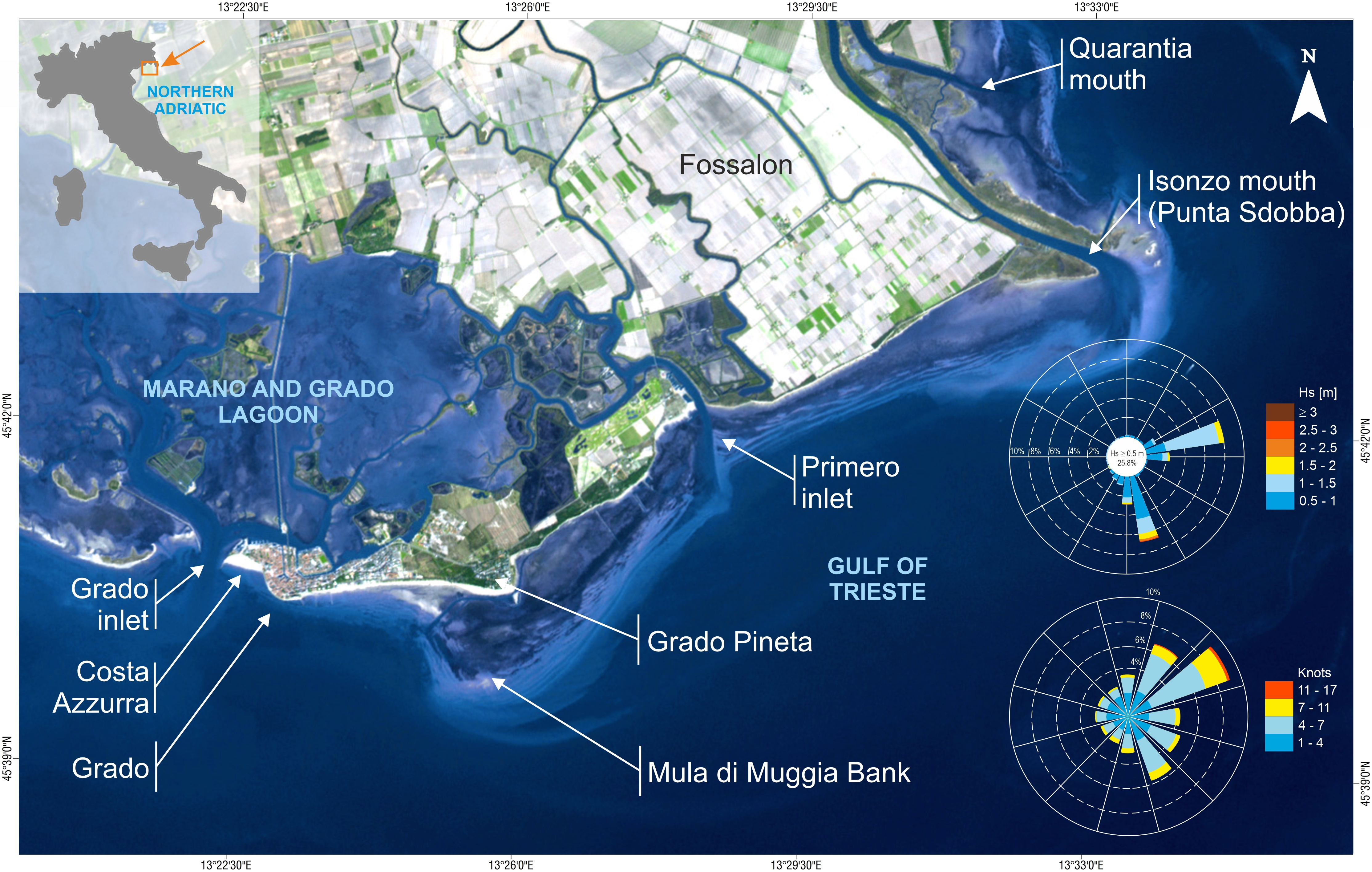
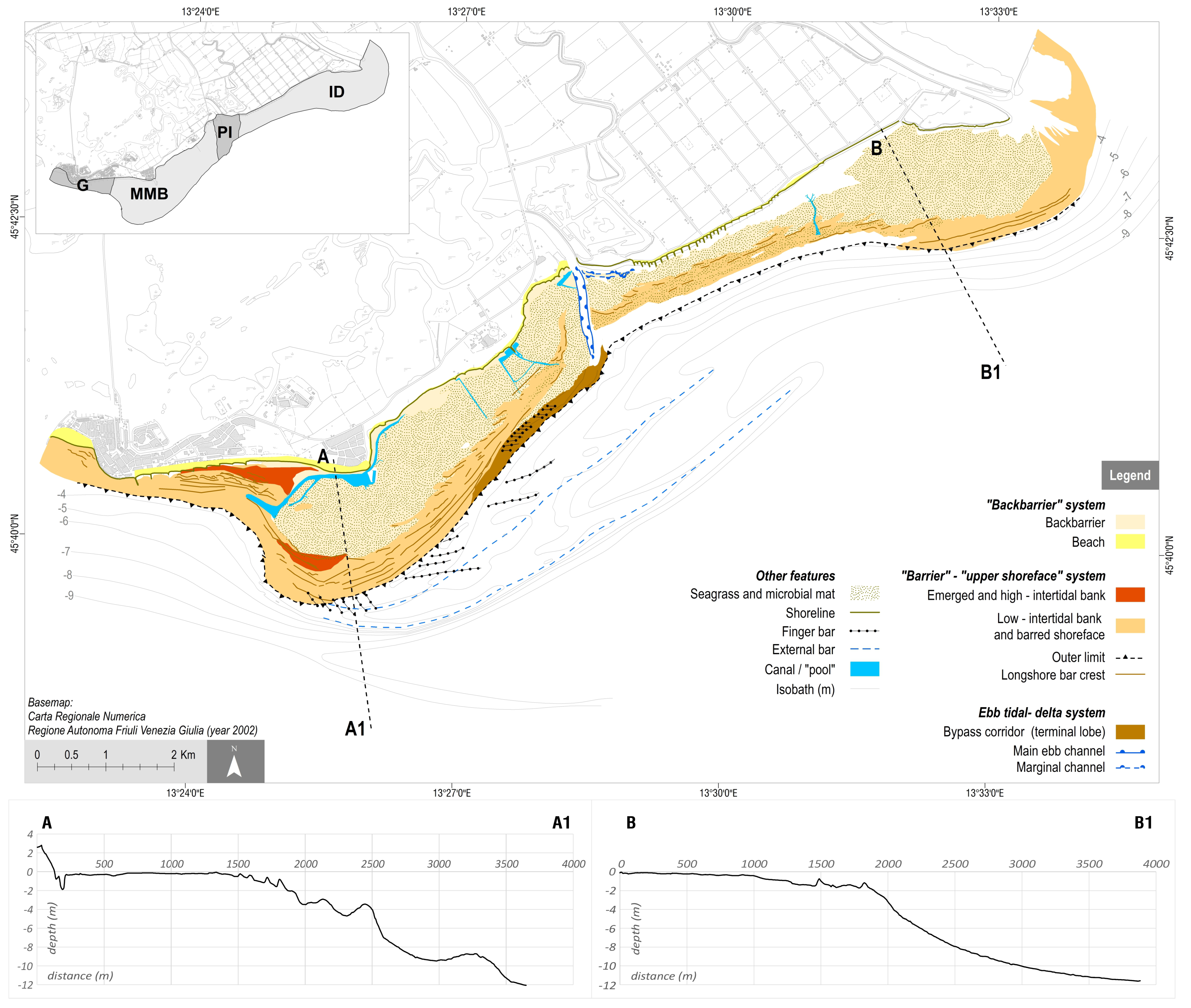
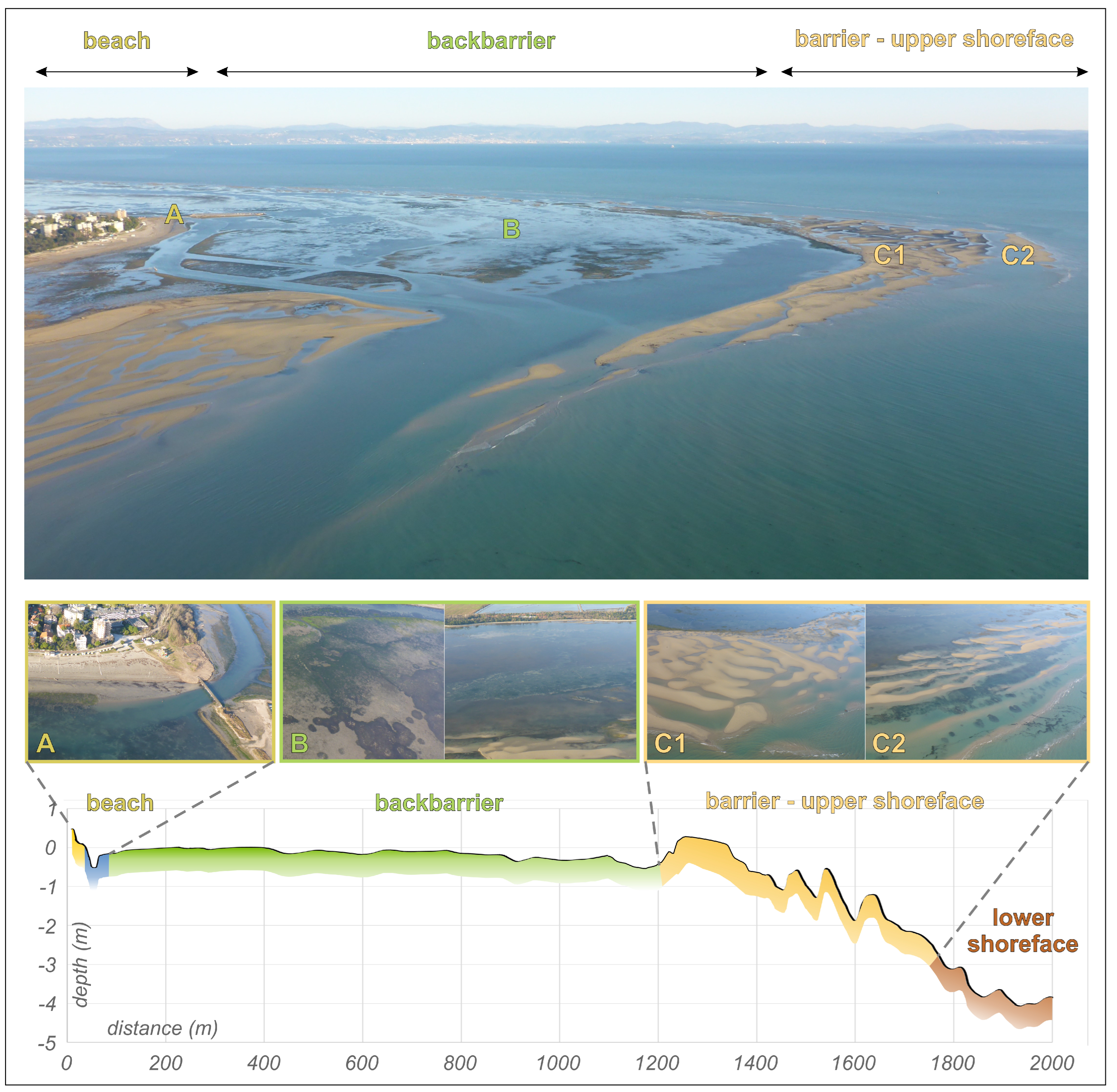
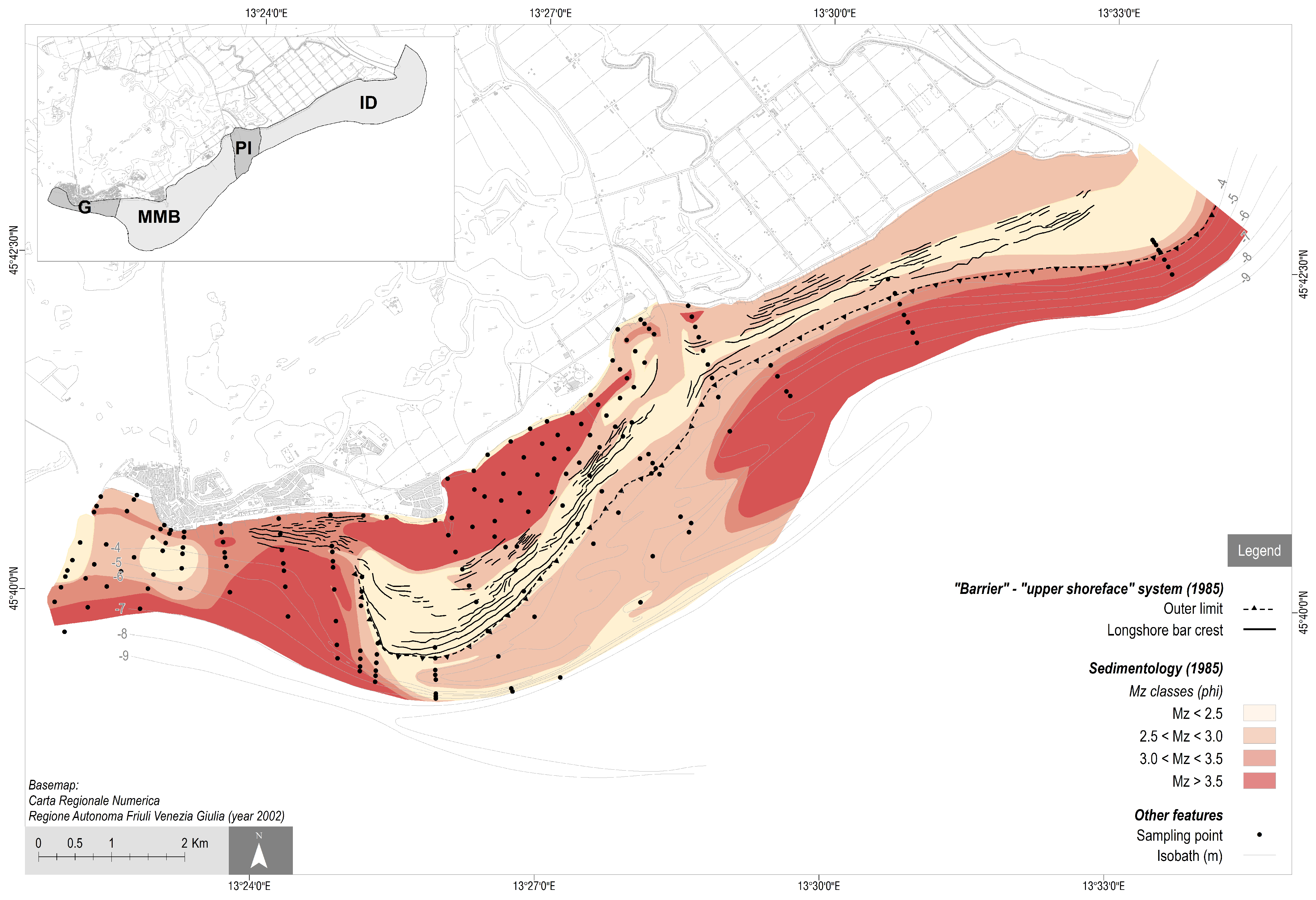

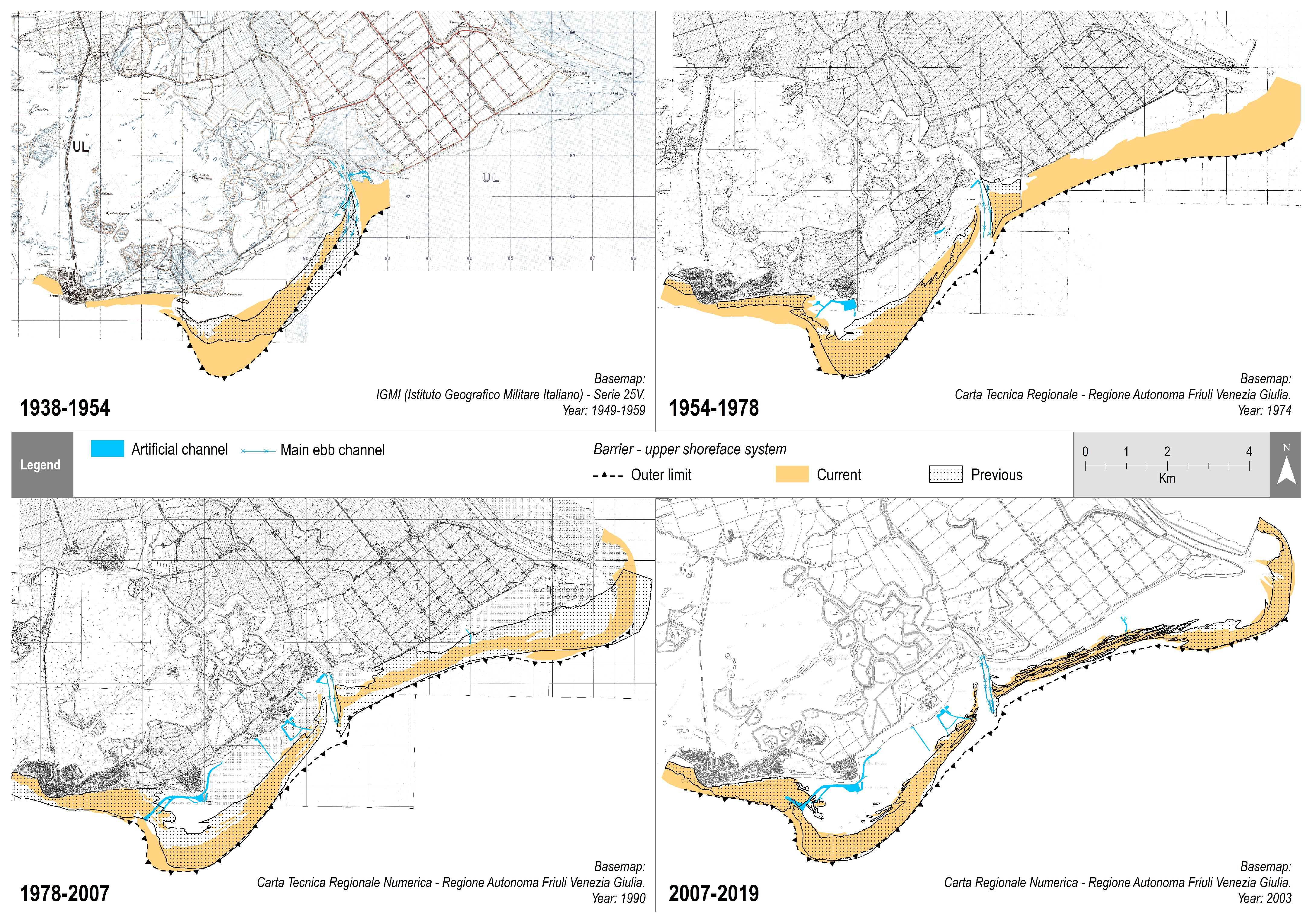
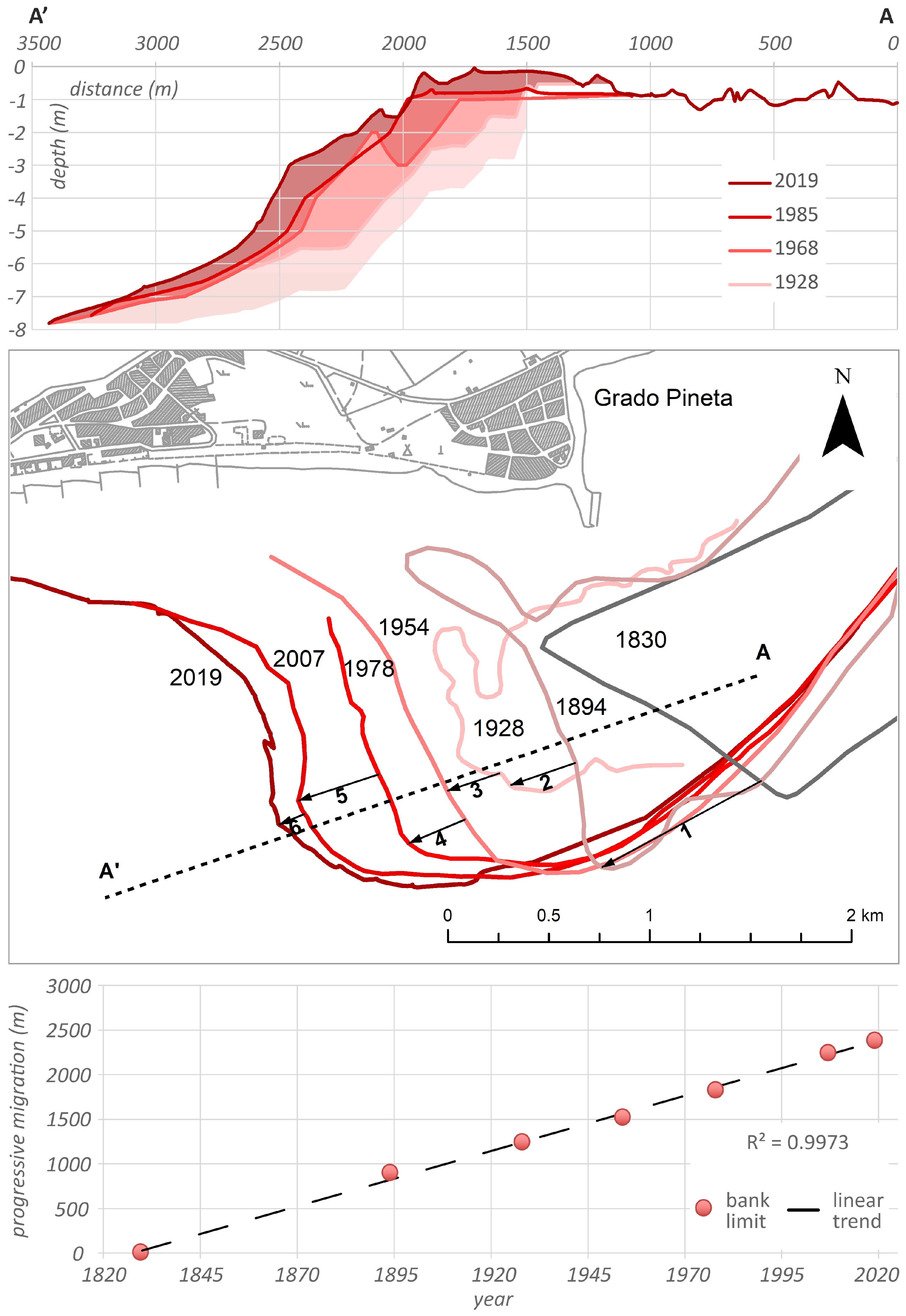
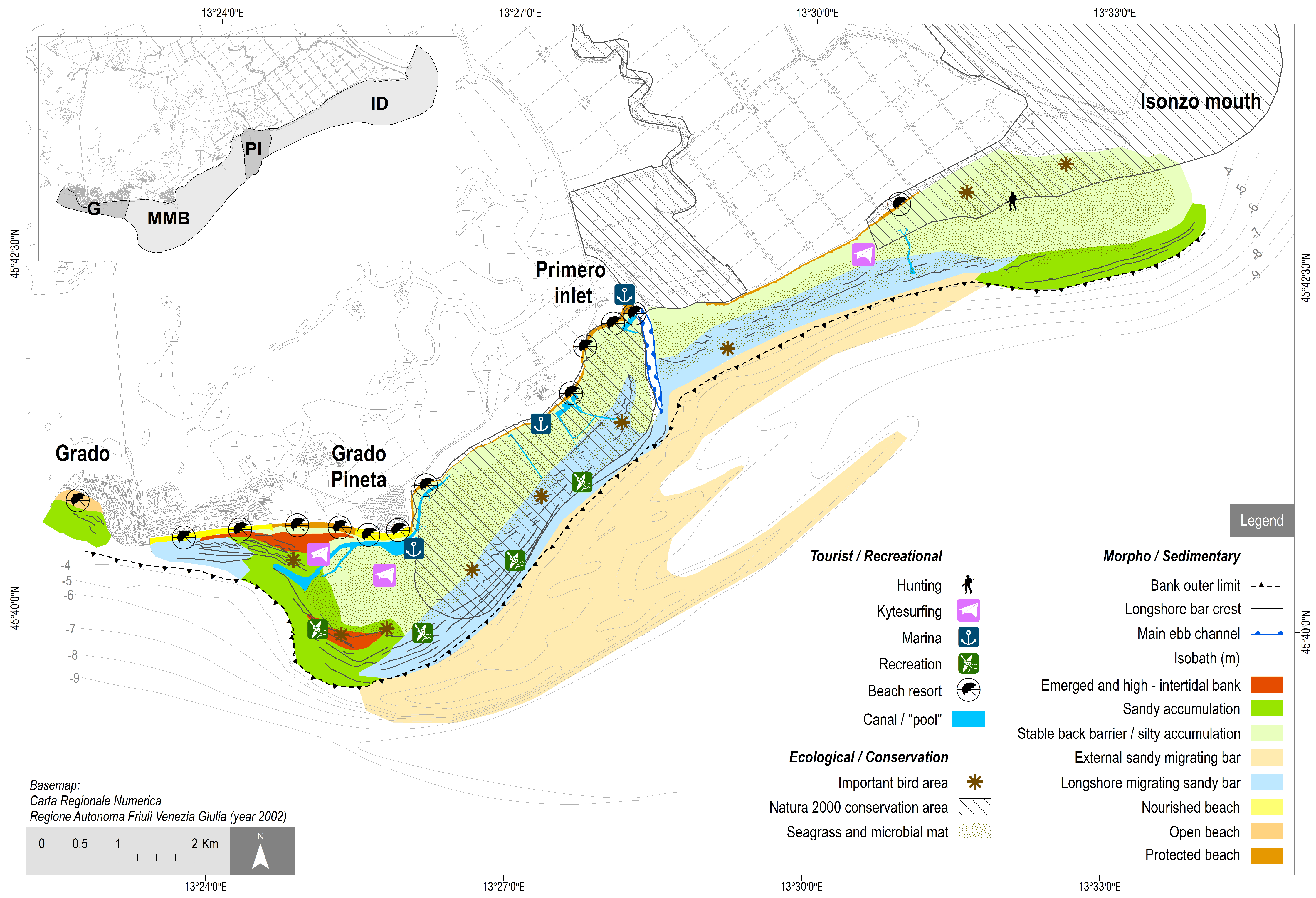
| Survey Year | Type of Source Data | References | Type of Resulting Data | |||
|---|---|---|---|---|---|---|
| A | B | C | D | |||
| 1798–1805 | historical map | Kriegskarte von Zach | • | |||
| 1822–1824 | historical map | Carta di cabotaggio del mare Adriatico, Istituto Geografico Militare di Milano | • | • | I | |
| 1830 | historical map | Franziszeische Landesaufnahme [61] | • | • | I | |
| 1869–1887 | topographic map | Franzisco—Josephinische Landesaufnahme [61] | • | II | ||
| 1894 | topographic map | Topographische Karte, Militärgeographisches Institut | • | • | II | |
| 1915–1917 | topographic map | Grado, F. 40II.S.E. della Carta d’Italia, Istituto Geografico Militare, 1917 Punta Sdobba, F. 40III.S.O. della Carta d’Italia, Istituto Geografico Militare, 1915 | • | III | ||
| 1927 | nautical map | Marina di Grado, Istituto Idrografico della Marina, 1928 (survey 1927) | • | III | ||
| 1938 | topographic map | Grado, F. 40II.S.E. della Carta d’Italia, Istituto Geografico Militare Punta Sdobba, F. 40III.S.O. della Carta d’Italia, Istituto Geografico Militare | • | • | III | |
| 1949 | topographic map | Grado, F. 40II.S.E. della Carta d’Italia, Istituto Geografico Militare Foce dell’Isonzo, F. 40III.S.O. della Carta d’Italia, Istituto Geografico Militare | • | • | IV | |
| 1954 | aerial photos | GAI (Gruppo Aereo Italiano) | • | IV | ||
| 1959 | topographic map | Foce dell’Isonzo, F. 40III.S.O. della Carta d’Italia, Istituto Geografico Militare | • | • | V | |
| 1968 | topo-bathymetric survey | Consiglio Nazionale delle Ricerche (CNR) Project “Studio del regime dei litorali” | • | V | ||
| 1972–1973 | sedimentological survey | Consiglio Nazionale delle Ricerche (CNR) Project “Regime e Conservazione dei litorali italiani”, 1970–1975 [54] | • | V | ||
| 1974 | topographic map | Carta Tecnica Regionale (CTR)—Regione Autonoma Friuli Venezia Giulia, flight 1974, published in 1978 | • | • | V | |
| 1978 | aerial photos | Consiglio Nazionale delle Ricerche (CNR)—Project “Dinamica dei litorali”, 1975–1980 | • | V | ||
| 1985 | topo-bathymetric survey | Regione Autonoma Friuli Venezia Giulia, 1985 [54] | • | VI | ||
| 1985 | sedimentological survey | Regione Autonoma Friuli Venezia Giulia, 1985 [54] | • | VI | ||
| 1990 | topographic map | Carta Tecnica Numerica Regionale (CTNR)—Regione Autonoma Friuli Venezia Giulia, flight 1990, published in 1993 | • | • | VI | |
| 2003 | topographic map | Carta Tecnica Numerica Regionale (CTNR)—Regione Autonoma Friuli Venezia Giulia—aggiornamento generale anno 2003 | • | • | VI | |
| 2007 | digital orthophoto | Available on Geoportale Nazionale [62] | • | VI | ||
| 2007 | topo-bathymetric survey | MIUR FISR—Project “Vector” (coordinated by CoNISMa—Consorzio Nazionale Interuniversitario per le Scienze del Mare), 2006–2009 | • | VI | ||
| 2018 | digital ortophotos | Lidar surveys—true orthophoto of the Regione Autonoma Friuli Venezia Giulia, 2017–2020 | • | • | VII | |
| 2019 | topo-bathymetric survey | University of Trieste, Interreg Project Italy-Croatia “Change We Care” [60] | • | VII | ||
| 2019 | digital orthophotos (UAV survey) | University of Trieste, Interreg Project Italy-Croatia “Change We Care” [60] | • | VII | ||
Publisher’s Note: MDPI stays neutral with regard to jurisdictional claims in published maps and institutional affiliations. |
© 2021 by the authors. Licensee MDPI, Basel, Switzerland. This article is an open access article distributed under the terms and conditions of the Creative Commons Attribution (CC BY) license (https://creativecommons.org/licenses/by/4.0/).
Share and Cite
Bezzi, A.; Casagrande, G.; Fracaros, S.; Martinucci, D.; Pillon, S.; Sponza, S.; Bratus, A.; Fattor, F.; Fontolan, G. Geomorphological Changes of a Migrating Sandbank: Multidecadal Analysis as a Tool for Managing Conflicts in Coastal Use. Water 2021, 13, 3416. https://doi.org/10.3390/w13233416
Bezzi A, Casagrande G, Fracaros S, Martinucci D, Pillon S, Sponza S, Bratus A, Fattor F, Fontolan G. Geomorphological Changes of a Migrating Sandbank: Multidecadal Analysis as a Tool for Managing Conflicts in Coastal Use. Water. 2021; 13(23):3416. https://doi.org/10.3390/w13233416
Chicago/Turabian StyleBezzi, Annelore, Giulia Casagrande, Saverio Fracaros, Davide Martinucci, Simone Pillon, Stefano Sponza, Antonio Bratus, Fabrizio Fattor, and Giorgio Fontolan. 2021. "Geomorphological Changes of a Migrating Sandbank: Multidecadal Analysis as a Tool for Managing Conflicts in Coastal Use" Water 13, no. 23: 3416. https://doi.org/10.3390/w13233416







